Try the new IKO website at https://beta.ikointl.com/
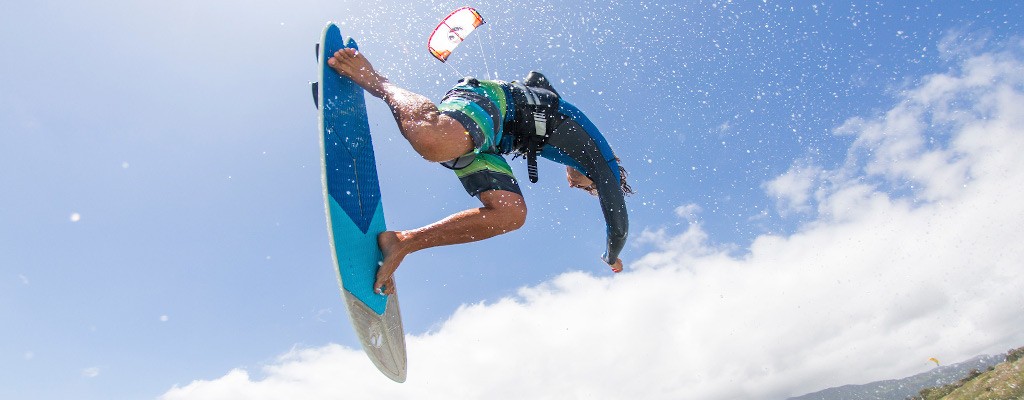
The Complete Beginner’s Guide To Know Everything About Kitesurfing
What Is Kitesurfing?
For some, it does not even ring a bell although, for others, it means everything and they build their life around it! Whether you have already witnessed it in person on your last vacation to the beach, maybe over the internet in your news feed or even in pop culture, for sure it made you wonder… What the heck are these guys doing dangling in the air under that big parachute? And how are they even doing it?
If we were to talk to someone in the early 1960s about space exploration, let alone landing on the moon they would have thought we were crazy. What if we were to tell someone today that they can have the time of their life by practicing a water sport that involves standing up on a surfboard, strapped in a waist harness while being pulled along by a large kite up 25 meters in the air? That person probably wouldn’t believe it. Well, here we are today with hundreds of thousands of people learning and practicing kiteboarding every year.
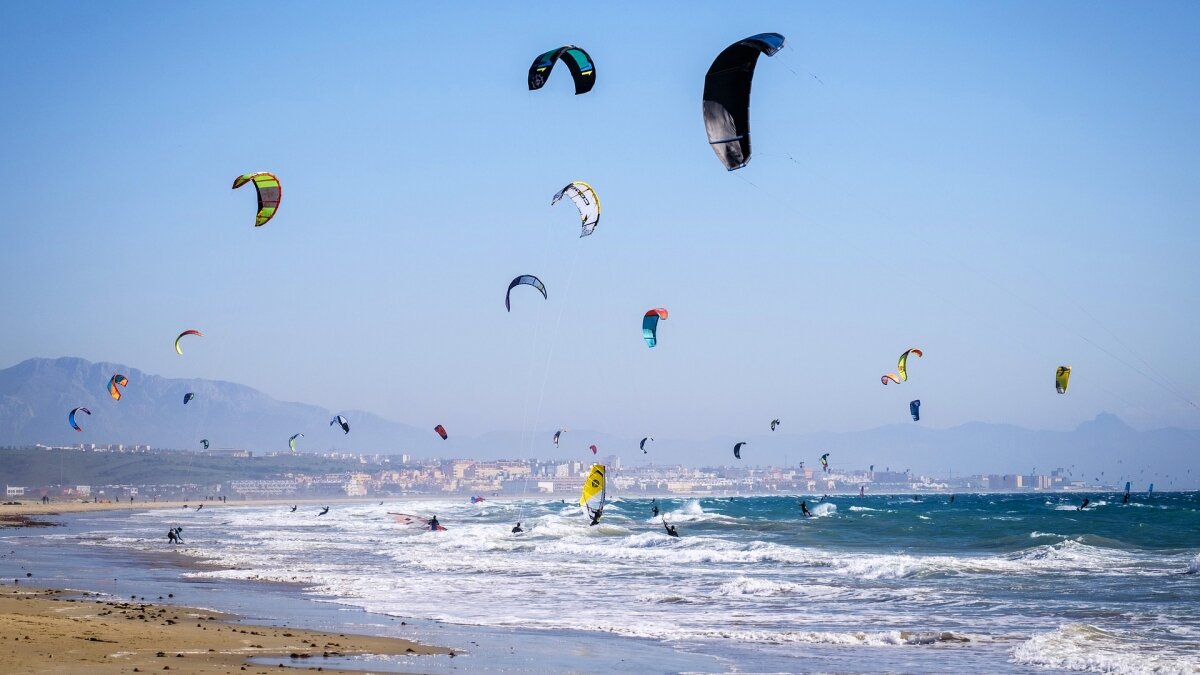
In this Complete Beginner’s Guide, we will go from the inception of the sport to where it is today and everything in between to understand what kitesurfing is all about. This guide will inform you about the history and origins of kitesurfing, the equipment, the environment, what it takes to become a kiter as well as the benefits of becoming one. Moreover, we will cover everything there is to know about the safety aspects of this action sport and the overall lifestyle and culture that has grown around it.
Just so you know, we have structured this guide to be read from top to bottom and/or skipped around per sections; read, share and use this guide as you wish; enjoy!
PS. The terms “kitesurfing” and “kiteboarding” are used interchangeably without any distinction and both refer to the exact same thing: the best activity in the world.
The History and Evolution Of Kitesurfing
To better understand what kitesurfing is, it is important we go back in time to when it began and follow its evolution to where we are today.
Now, depending on who you talk to or where you look for your information, kitesurfing might have started “officially/unofficially” somewhere between the 80’s and late 90’s. Within the kiter community, the question of who was the first kiter and when kitesurfing was invented is still up for debate. Truth is there is no definite answer, but what we do know is that the sport has evolved tremendously thanks to many passionate and hardcore kiters who invested time, money and efforts in making this sensational wind-powered activity grow as the exciting sport we know today.
Late 20th Century: the inception of a new global action sport
So, what do we know? Well, what we do know for sure about kitesurfing is what has been officially documented. In 1977, a patent for kitesurfing was filed by Gijsbertus Adrianus Panhuise from the Netherlands which unfortunately for him did not attract any commercial interest.
Seven years later, in November of 1984, the French Legaignoux brothers filed a patent for the first-ever inflatable kite design (pretty forward-looking for their time). That feature enabled the rider to instantly relaunch the kite in the water, a decisive improvement upon which many current kite designs are nowadays still based on.
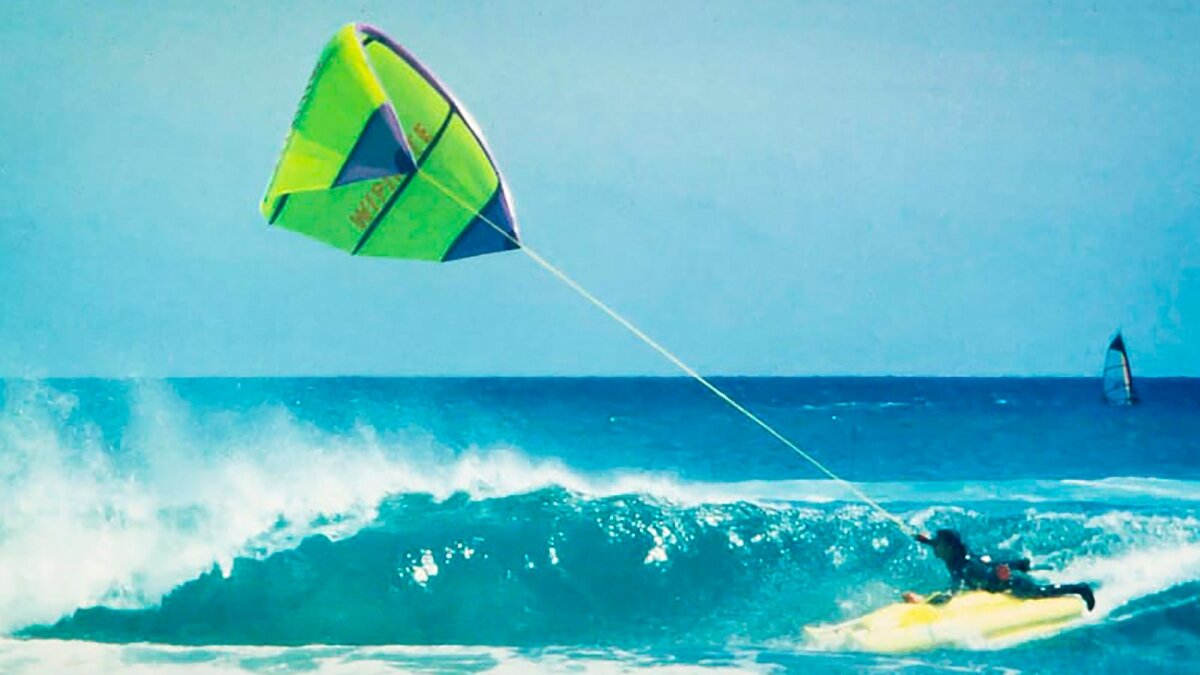
From that moment on, many other kitesurfing enthusiasts began experimenting with the sport. As the community grew, the designs of the kites and the sport as a whole started not only growing, but drastically evolving due to so much research and development in all aspects from safety to performance.
The late 20th century is where most of the kitesurfing pioneering has happened. For example, the first kites that were invented did not have a “depower” function which meant that they were always fully powered and subjected to the wind’s will. As soon as you would launch your kite, the action began with no moment to rest and any error could prove catastrophic. Today kites are much more manageable and stable thanks to the 4-lines design and the “depower” function.
Start of the 21st Century: the explosive growth of kitesurfing
Since the inception of kitesurfing up until the point of you reading this, kitesurfing has drastically changed. The 20th Century has set up a solid foundation for us to build off in the early 21st century.
The reason for this insanely quick evolution in equipment efficiency, globalization and safety comes down to seeing more and more individuals taking interest in kitesurfing. Every year there are several thousand newly certified recreational kitesurfers around the world.
What is remarkable is not only the growth but the diversity of kiters personas within the sport. Contrary to popular belief, kitesurfing is not only attracting top athletes and adrenaline junkies - kitesurfing most recently has begun attracting people of all ages and all horizons from kids to grown-ups, fathers, mothers, lawyers, ex-presidents, dentists, plumbers, fortune 100 company CEOs and pretty much converting in anyone who tries it.
The 2000s and onwards will not only be the biggest phase of expansion for kitesurfing, but it might also even be the most interesting time period for kitesurfers. This expansion, in the end, is built upon the foundations of organizations that are focused on the education and safety aspect of kitesurfing.
The IKO (International Kiteboarding Organization) was founded in 2001 around that mission to foster a safe and sustainable growth of kitesurfing through education, training and the promotion of safe practices all around the world (for more information about IKO, check out the IKO’s about page).
Around the turn of the century, the original brands such as Wipika, Cabrinha, F-ONE, Naish amongst other brands were at the forefront of evolving the equipment designs. The gear was becoming more efficient and safer in accordance with the new research and development. Without such collaboration between the education sector and the commercial sector, the kitesurfing world would not have had the growth it has had so far.
In all, those individuals and organizations believing in their favourite sport and investing time and money have helped transition kitesurfing from a highly risky activity to an action sport that everyone can enjoy.
What Equipment Do You Need To Kitesurf?
As we stated above, kitesurfing would not be possible if it wasn’t for the equipment that we use. Here, we will talk about the different types of kites, harnesses, boards and other pieces of gear one might use. Read on to get further insight on the equipment that enable kitesurfers to ride with the wind and defy the elements!
Kites
The most obvious piece of kitesurfing equipment is usually the first thing that attracts our attention looking at a beach... the KITE! The kite is the most essential part of kitesurfing (duh!).
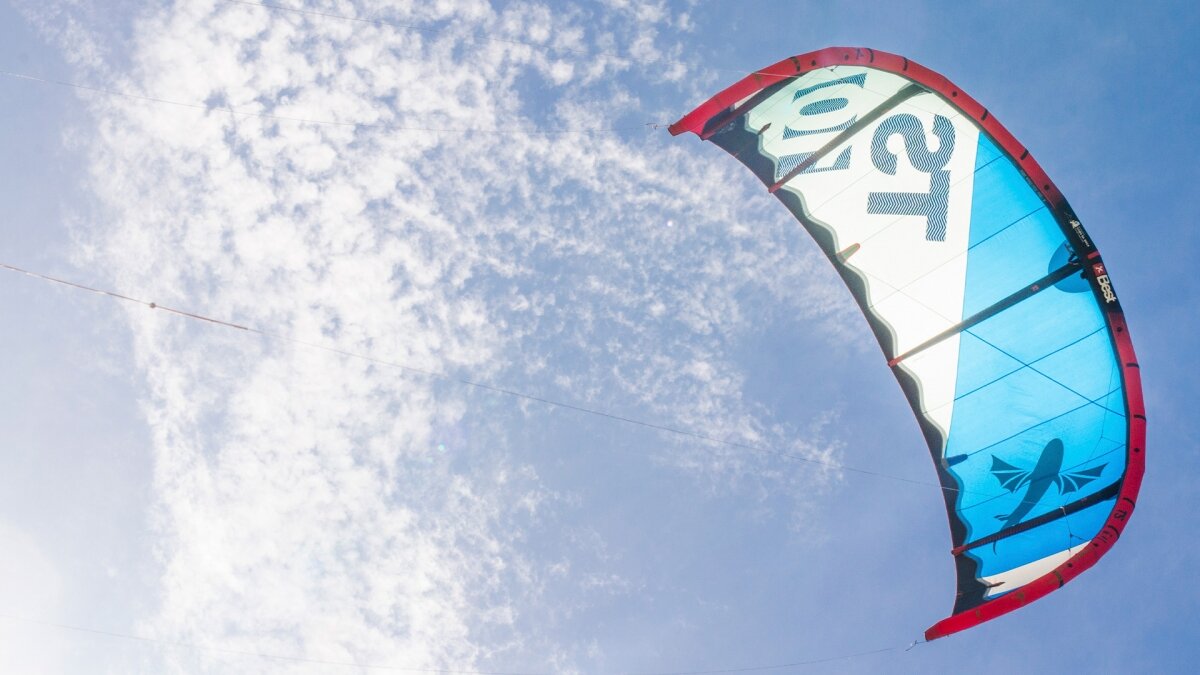
The kites vary in sizes and shapes depending respectively on the strength of the wind, your weight, your level and the discipline you’re practicing. Any time you see a kite on the water, you can notice a number on the canopy of the kite that indicates its size in square meters. Most kites are between 5 and 18 m2.
Types of Kites
Since the beginning of kitesurfing, there have been many different variations of kites. Here’s a look at the two main kite categories: LEI and Foil.
LEI (C-Shapes, hybrids, SLE/Delta/Bow)
A Leading Edge Inflatable (LEI) kite is a single skin kite with inflatable bladders providing structure. LEI kites are flown using a control bar that has either 2 (old school), 4 (most common and modern) or 5 (C-Kites generally) lines.
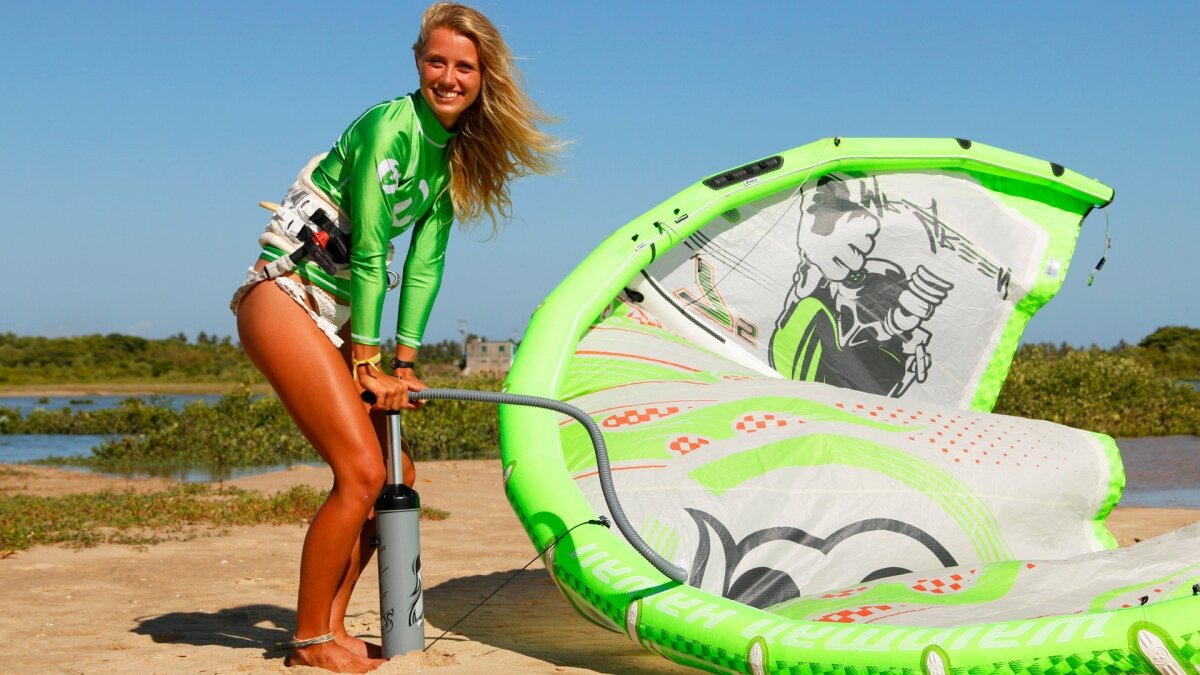
The LEI kites are the most common for kitesurfing since they are great kites for water use. This is because of the inflatable bladders which cause the kite to float on the water surface. Unlike a foil kite, a LEI kite can sit on the water for an indefinite time and still be re-launched with relative ease.
Leading Edge Inflatable kites can be broken down into four designs: C-kites, hybrid kites, delta kites, and bow kites. Much of this is thanks to the Legaignoux brothers and their patented invention of the inflatable kites. Compared to foil kites, LEI kites are easier to fly, relaunch more quickly and are more stable in gusty winds.
Foil kites (ARC, Bridled)
Unlike LEI kites, foil kites have no inflatable bladders and instead work with either open or closed air cells that fill up and take shape with the airflow entering the kite. If the kite is dropped in the water, the air cells can potentially fill up with water and cause the kite to sink. This is the reason why we use foil with valves for water practice.
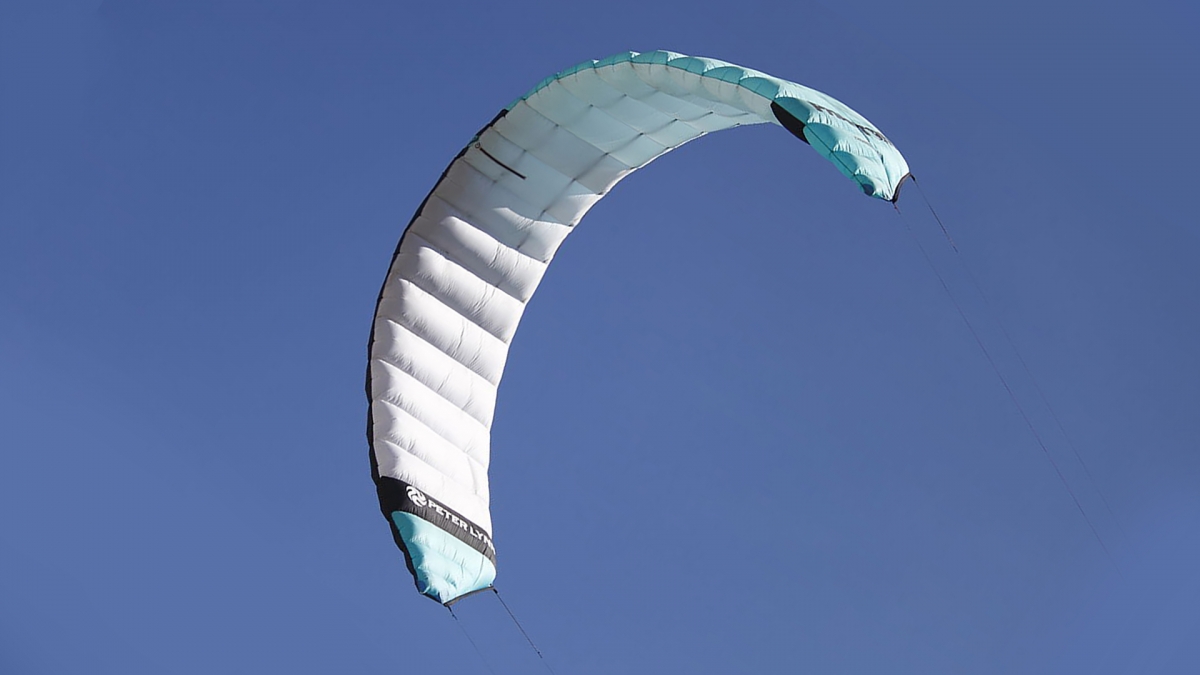
However, foil kites are the most efficient design of kites as they can generate much more power and operate in lighter winds compared to LEI, although their ease of use is lower compared to the LEI. Similar to LEI kites, you use a control bar that is connected by control lines to steer the kite.
The easiest and quickest way to distinguish a foil kite from a LEI kite is by the shape. Foil kites have a much higher aspect ratio (the proportion between the surface area of the kite and it’s span) which makes them look thinner and longer in length, very similar to a paragliding wing.
Construction
Kites are generally made from a material called ripstop polyester (contrary to popular belief, they are not made of ripstop nylon which is more rip and tear-resistant, though less UV resistant). In addition to the ripstop fabric, you have an inflatable plastic bladder that spans the front edge of the kite as well as the smaller struts that are perpendicular to the main bladder. When you inflate the bladders, it gives form and rigidity to the shape of the kite.
You will see that in addition to the ripstop material some kites will use a mix of ballistic Kevlar, Dacron DP175, high-tenacity Dacron, neoprene, polyurethane and/or Cuben fibre to reinforce and give the kite more durability as well as overall shape rigidity while in flight.
Fun Fact: Teijin Frontier, a Japanese textile company is the leading supplier of fabrics to the kitesurfing industry with its “techno force formula” found in over 90 percent of the worlds kites.
Why do kites fly and pull?
So, what’s the trick? Is there a motor hidden somewhere? Is it some form of dark magic?
Many people assume that a kite flies because of the wind “pushing” inside the canopy of the kite. That’s actually wrong. To understand why kites fly and pull, let’s take 30 seconds and dive into the science behind it.
There are four forces at play here: Lift, Weight, Drag and Thrust. These forces affect kites the same way they affect airplanes, paragliders, flying saucers (not sure about this one actually) or pretty much anything else that flies. Here is the breakdown:
- Lift is the upward force that pushes a kite into the air. Lift is generated by differences in air pressure, which are created by the air flow passing above and below the body of the kite. Kites are designed so that the air particles moving over the top of the wing flow faster than the air moving over the bottom.
- Weight is the downward force generated by the gravitational attraction of the Earth on the kite. The force of the weight pulls the kite toward the ground.
- Thrust is the forward force that propels a kite in the direction of motion. Airplanes, for example, generate thrust with its engines while a kite must rely on the tension from the lines and moving air created by the wind.
- Drag is the backward force that acts opposite to the direction of motion. Drag is caused by the difference in air pressure between the front and back of the kite and the friction of the air moving over the surface of the kite.
So basically to launch a kite into the air, the force of lift must be greater than the force of weight. To keep a kite flying steady the four forces must be in balance. Lift must be equal to weight and thrust must be equal to drag.
Still there? Okay, good. Maybe that was longer than 30 seconds, but we hope you learned something new. The main takeaway is that a kite flies not with the wind, but through the wind as an airplane wing would do. We bet not every kiter know this!
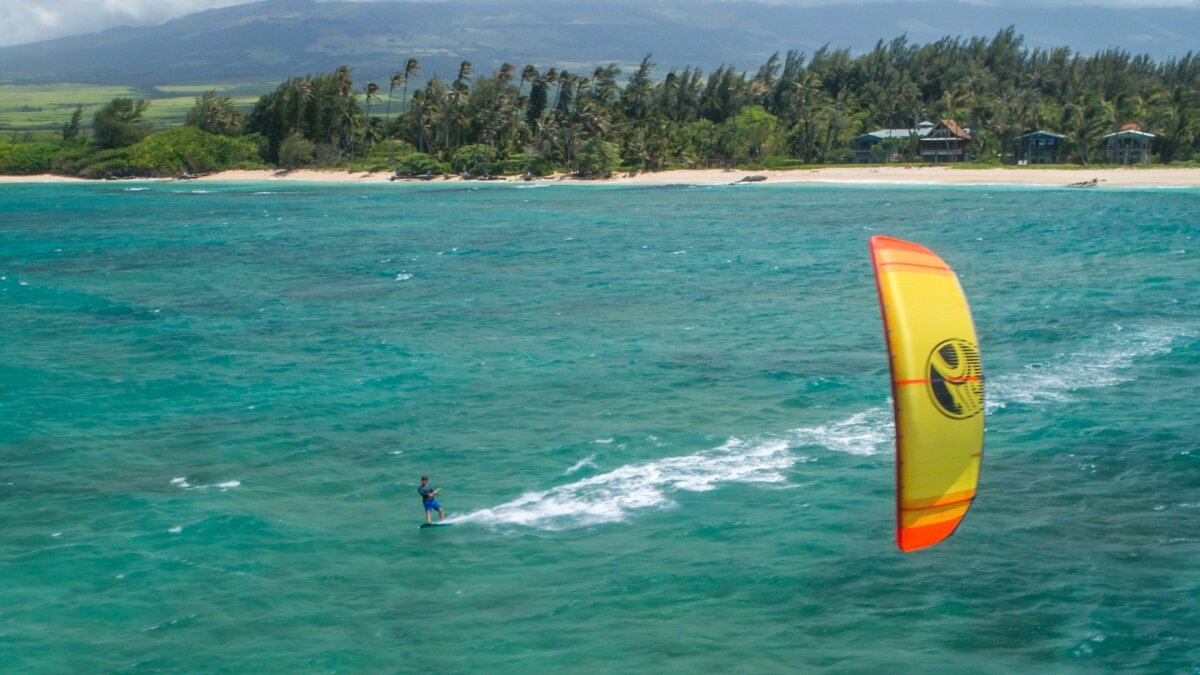
Why can you jump and fly with a kite?
It has everything to do with the board energy as well as the kite energy. We won't go too in-depth here (our nerd talk above was enough) but basically when you are kitesurfing you are using your kite to generate energy (or “power”) which translate into speed as you edge your board in the water against the pull of your kite. In other words, when you generate more speed, you are simultaneously generating more power.
Then if you edge hard enough into the wind, you will pop off the water, almost like energy exploding! Combining this “popping” energy in the board simultaneously with the energy of moving the kite quickly from a 45 degree angle to a 90 degree angle (sending the kite to “the zenith”, straight up above your head) will cause you to jump and break free from earth's gravitational pull for a moment (and looking like a total badass doing so).
Believe it or not, even if this looks complicated, once you are riding at a certain level all of this becomes more intuitive than it sounds and makes sense. During advanced kitesurfing lessons, your instructor will help you figure it all out!
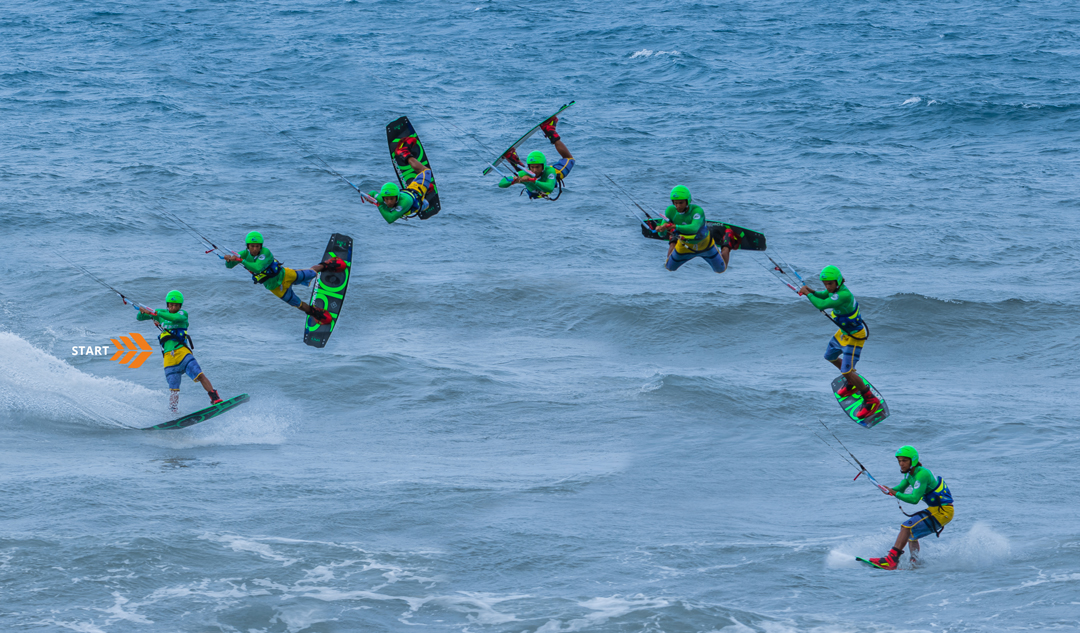
Control Bar and Lines
Having a kite is essential but a kite without a bar is like a motorcycle without a handlebar - pretty much useless. Combining both a kite and a control bar with lines to attach to the kite will bring you one step closer to having all the equipment needed for kitesurfing.
Control bars vary in lengths, weight and comfort depending on the manufacturer design. Some bars will be shorter and others will be longer anywhere between 30cm to 60cm. Smaller bars are generally made for smaller kites as larger bars are made for larger kites (pretty straightforward here). The bar sizes change in accordance with the kite size and allow for proportional leverage and easy control.
You will notice when flying different kites that some bars are lighter and others are heavier. This slightly affects performance but mainly affects the rider’s comfort. Some people like to have a bolder and heavier feel in their hands while others prefer a thinner and lighter bar. In the end, all control bars are created with the same goal in mind: to control the kite as efficiently and safely as possible.
When the rider steers the kite, the input in the bar is transmitted to the kite through the lines. Now, how many lines vary on the manufacturer and the type of kite you are flying. Generally, you will have either 2, 4 or 5 lines with varying line lengths from 5 meters to 24 meters (sometimes more). The length of the lines will change depending on which step you are in your progression since shorter lines are recommended when learning to fly a kite while 20+ meters lines are used to start riding.
Two of those steering lines are attached on the outside parts of the bar (backlines) and then 2 (or sometimes 3) of those lines (front lines) are going through the center of the bar; the main safety system is attached to one of the front lines.
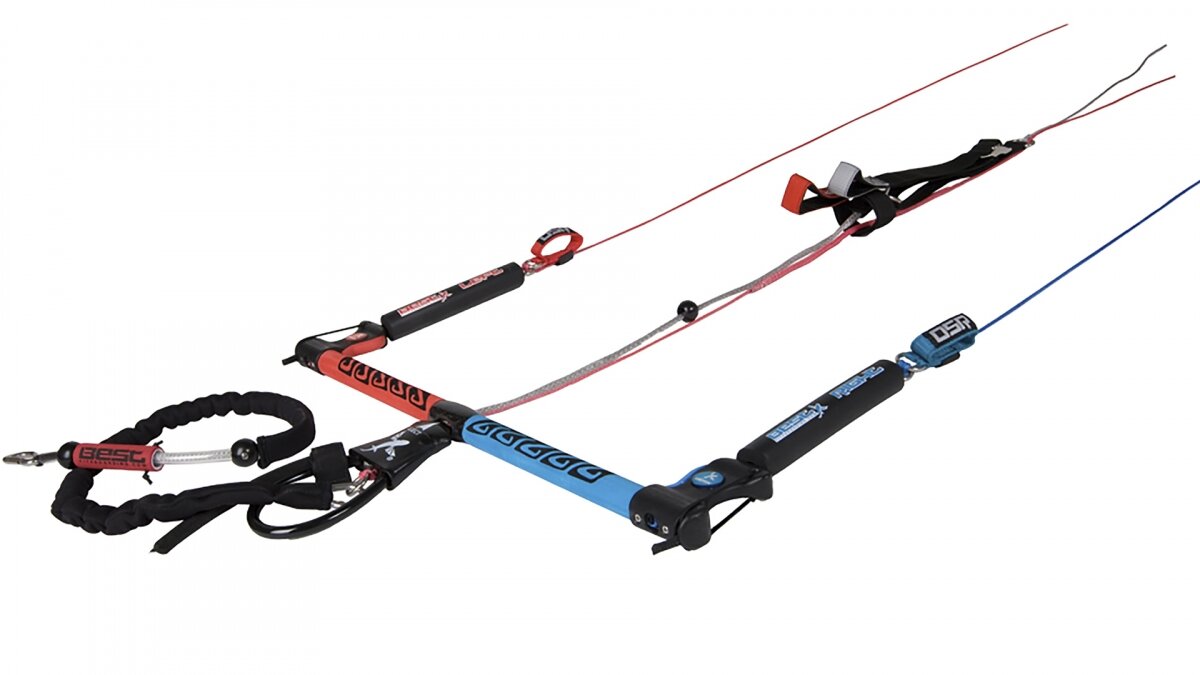
The safety system of each control bar might vary slightly though the more modern and safer equipment works with a “push-away - quick release system” that opens the “chicken-loop” and decreases the power of your kite. Doing this engages a re-ride safety system which instantly flags out the kite and stops it from pulling you.
The quick release safety system has been one of the main reasons for the expansion of the sport. Previously it did not exist and made kitesurfing classified as a more dangerous activity since you had no way to decrease the power of the kite. This improvement along with the depower system has made the sport much safer and more accessible.
To recap... The flying kite is attached with lines to a control bar and then the chicken loop is hooked onto your …? Hooked to what you may wonder? Read the next paragraph to find out.
Harnesses
If you have the strength and endurance of Superman, you can skip this section. If not, you will need to wear a harness like the rest of us.
Basically, your harness connects you to your control bar (through the chicken loop) and transfers the pull of the kite to your waist. As you can imagine, holding the bar and the whole pull of the kite with your hands would be extremely exhausting! This is why we use a harness to leverage the power of the kite.
Harnesses come in many different shapes and sizes. Mainly, you will have two types: waist harnesses which wrap around your waist or seat harnesses which wrap around your legs and hips (similar to the ones used for rock-climbing or sailing). Seat harnesses generally offer more support and comfort but might restrict your ease of motion if you’re into advanced tricks.
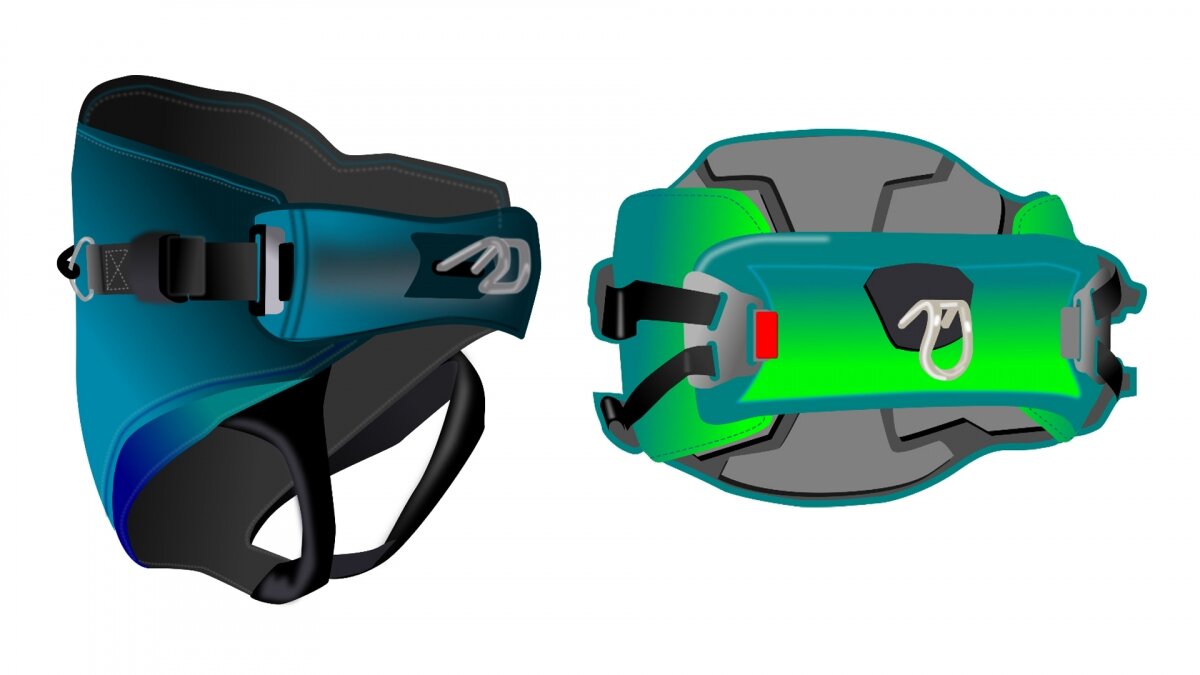
Harnesses are categorized as either soft - medium or hard; this is in reference to their overall rigidity (and is a question of personal preference and comfort). The attachment point of the harness to the chicken loop is a rounded and fixed metal hook called the spreader bar (which literally spreads the pull of the kite through the entire structure of the harness). Some of the spreader bars offer a “sliding” mechanism that grants more mobility to the attachment point and are generally used by wave riders and foilers to expand their range of motions when out performing on the water.
What is important to take out from this section is that there are various different options out there and that it is important to find the right harness. It is often overlooked even though it is very important to have not only a comfortable harness though a quality one as it is essentially what is holding everything together whilst kitesurfing.
Boards
Unless you can walk on water you are probably going to need a board to go out kitesurfing!
Boards vary in shapes and sizes which affect their performance, whom they are suitable for and the discipline you are practicing. The most common board you will see people riding is known as a twin tip and the other boards you might see will be directional boards and foil boards. These are the three most popular types of boards; although you might have seen footage of some creative kitesurfers who decides to ride skis, a kayak, skimboard or their old fridge door.
Twin Tip
Twin tip boards are the most common type of boards. The name refers to the symmetrical outline of the board (both tips are identical) which enables the rider to go left or right without switching feet. A Twin tip is the board you will use when learning kitesurfing and most probably the type of board you use throughout your progression.
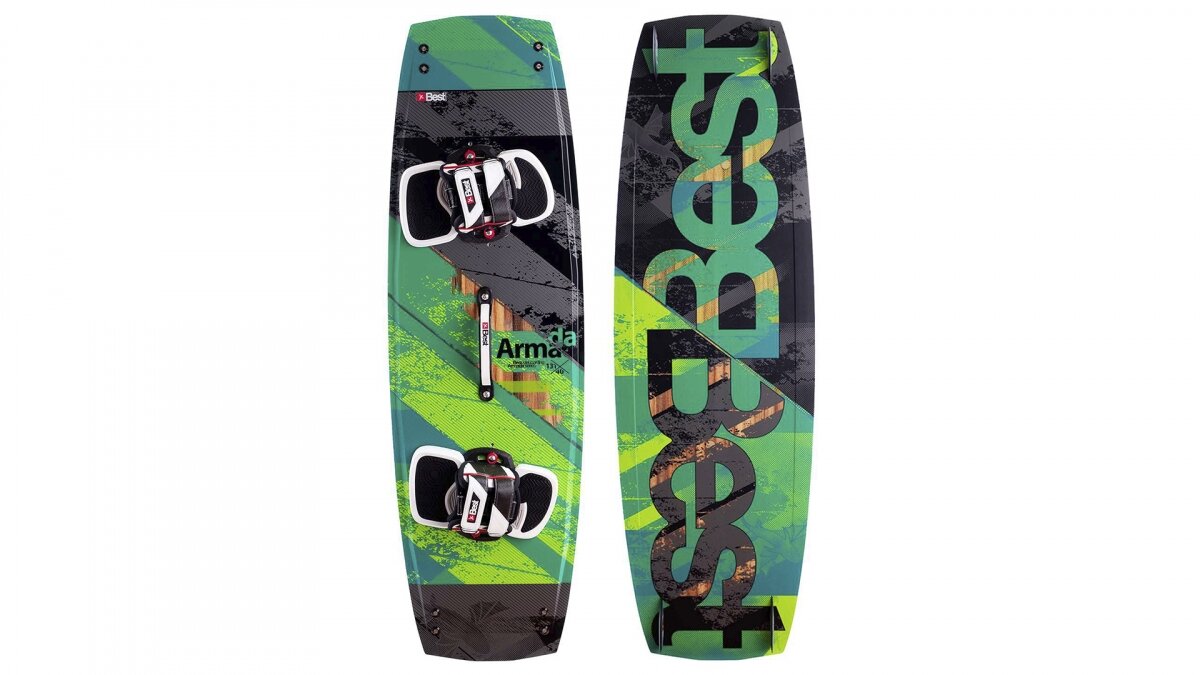
Twin tip boards vary in sizes and shapes depending on the rider’s weight and skill level. The average size for an adult is around 137cm long x 42cm wide while the average size for a kid would be around 127cm x 36cm.
Directional board
Directional boards are primarily designed for wave riding as they enable the riders to carve through the swell while being pulled by the kite and experience a feeling close to surfing. Moving from a twin tip to a directional board is a thrilling and challenging step that opens up a whole new perspective on the sport.
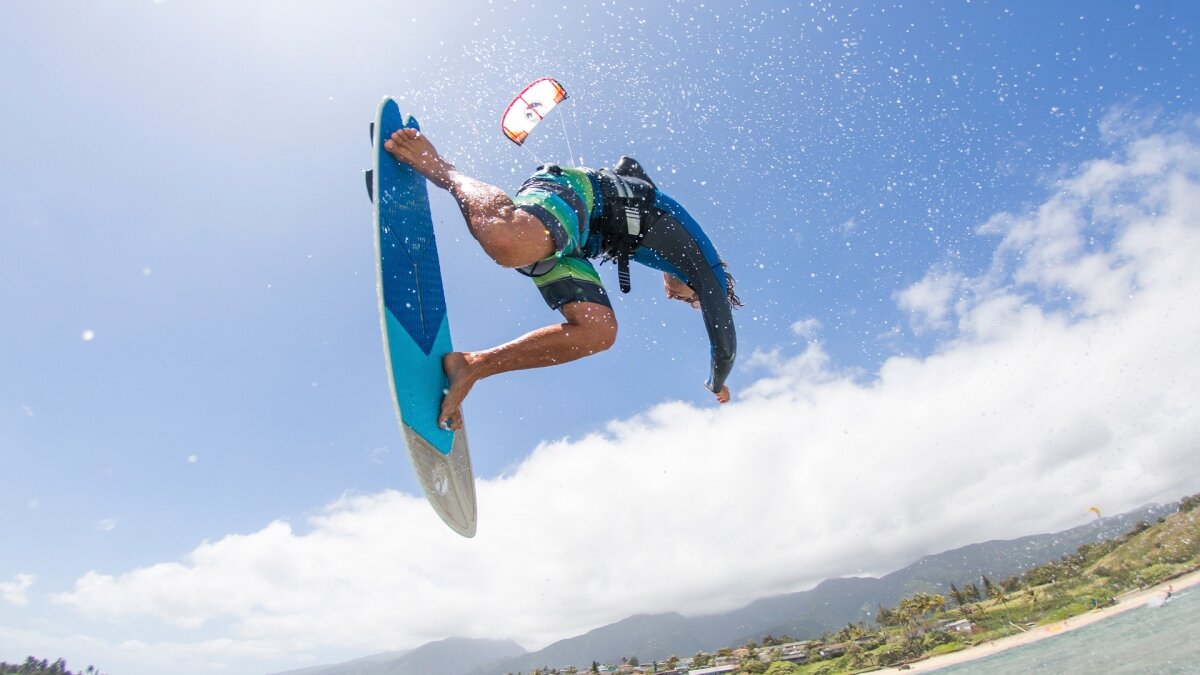
As the name implies, directional boards enable the rider to go in one direction at a time (to change direction, the rider has to change its feet position or ride toeside). Directional boards also come in various shapes and sizes (even more variety than twin tips) depending on the riders’ preferences, skills, and the waves they are riding.
Hydrofoil board
Hydrofoil boards are the latest craze. A hydrofoil board has a vertical mast (varying from 15-115cm long) attached to a wing and stabilizer which act as a plane underwater to lift the board above the water surface.
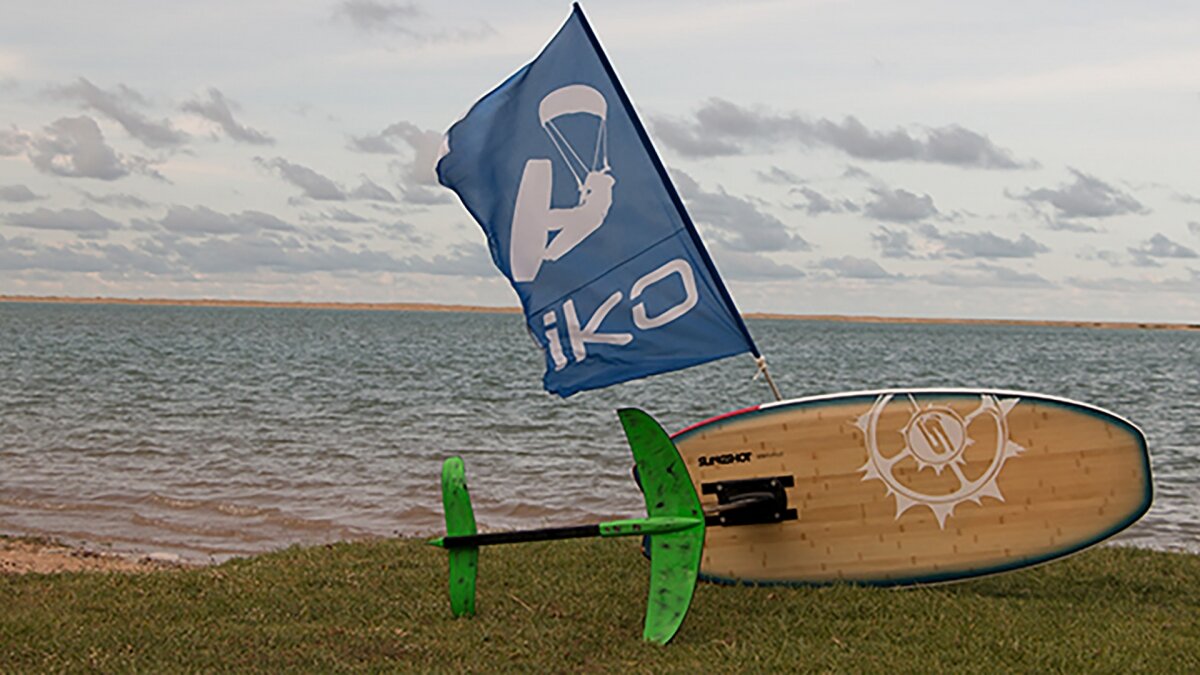
How does it work? Basically, as you gain speed, you generate more lift which makes you hover above the water. Using your balance, you can then glide around with very little drag in the water. No wonder why many people compare foiling to the sensation of riding a magic carpet!
In some ways, the water particles flowing above and under the foil wing lift you above the water the same way that the air particles around your kite lift you in the air. How cool is that?
Foil boards have very recently helped open up the kitesurfing perspectives even more as they are super-efficient in lighter winds conditions which enable us to enjoy our sport even more often than before.
Other equipment
Now you might be wondering what other equipment could you possibly need if you already have a kite, a board and a harness? Although some pieces of equipment might not have a direct impact on the fact that you’re riding or not, they are as essential since they will provide support and increase safety.
- Short kite leash: A safety leash connected to the front part of your harness and onto the safety line which allows your control bar safety system to be efficient. It enables you to flag out your kite by activating the chicken loop quick release in case you are in a dangerous situation. If the solution is not resolved by releasing your chicken loop quick release, you can completely detach from your kite by using your kite leash quick release.
- Helmet: This one should be a no-brainer… Kitesurfing is an action sport and in the midst of action, many things can happen. A helmet protects your head from falling kites, swinging boards, obstacles, hazards on the beach, and yes, even water impact.
- Buoyancy aid: Kitesurfing involves water and water sports involves swimming. You might be a good swimmer, but waters can be treacherous even on a perfect day. A personal flotation device (PFD) of 50 Newtons can give you just the buoyancy aid you need to stay afloat while you learn, catch your breath after a crash or help you swim back to shore if you need to.
- Line cutter: A line cutter is used in rare cases of emergency to cut a line from your kite or from some else’s (for example, if a line gets wrapped around you or one of your limbs). Modern harnesses generally come with a slot under the spreader bar where you can store your line cutter and access it fast (if you take a lesson with IKO, your instructor will have a line cutter and will show you how to use it).
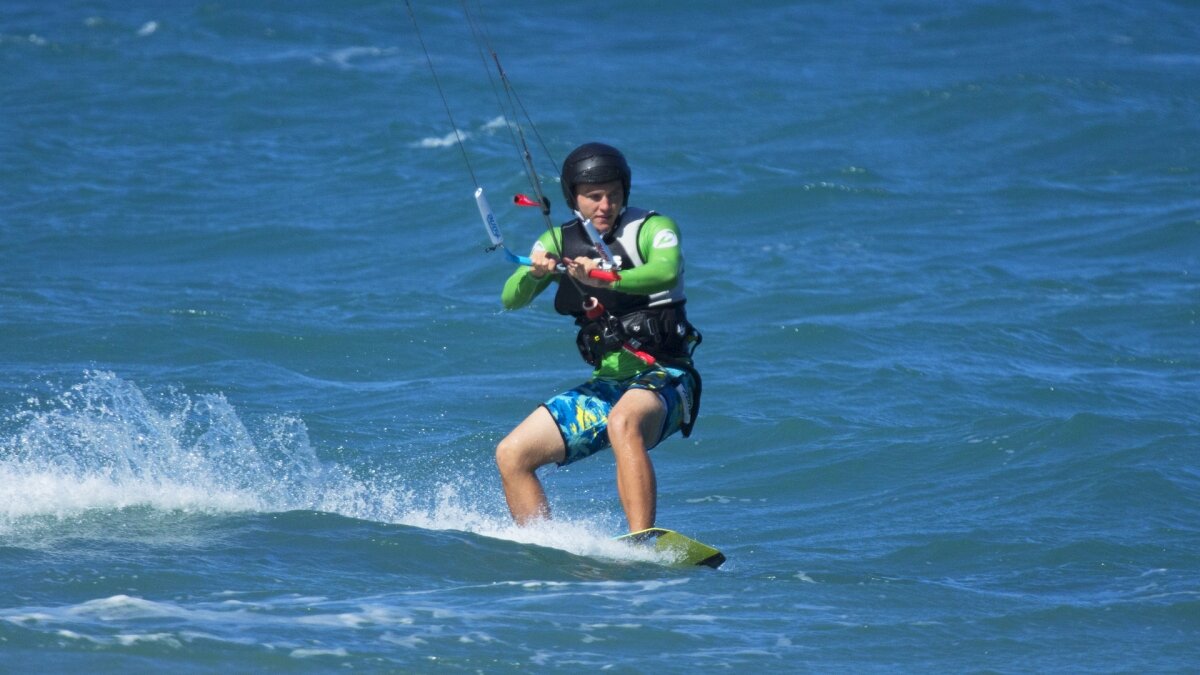
In addition to those four essential kitesurfing accessories, you can also use: water sport sunglasses, sun protector, hat, rash guard, GoJoes (safe board recovery aids), walkie talkie systems, waterproof mp3 players, etc. This extra equipment is not essential to kitesurfing though can enhance the experience.
Oh, and what about using a board leash? Well, let’s make it clear: NEVER use a board leash at any point. Board leashes are dangerous and can cause injury to head, back and spine. To retrieve your board on the water, a competent instructor will teach you how to body-drag upwind, an essential skill to become a truly independent kiter.
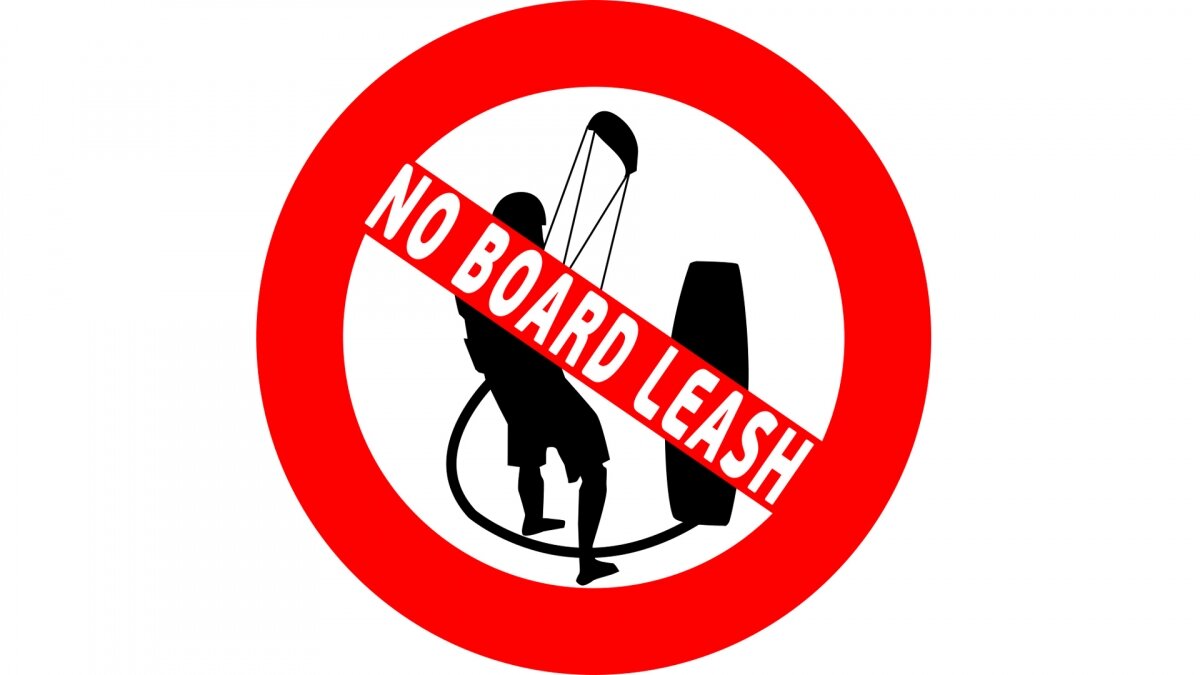
What Conditions Do You Need To Kitesurf?
It’s true to say that the sport of kitesurfing relies heavily on the equipment you use. But a car without fuel won’t go very far just as a kite without wind is pretty much useless. Indeed, the environmental conditions play a determining role in our favorite activity, this is why we are going to take a look at what it takes to go out there kitesurfing.
The Elements
The two major elements at play when we go kitesurfing are the wind and the water. The wind will make your kite fly while the water will allow you to glide along its surface.
Wind
So let's talk about the wind first! For mere mortals, the wind often goes unnoticed in their daily lives. But for us, kitesurfers, the simple sight of tree branches swaying or the whistle of a breeze can trigger a sudden urge to leave the office and head straight to the beach.
But where does it come from, anyway? Is there a big solar-powered fan somewhere? Well, not quite.
Wind is air particles in motion. It is generated by the uneven heating of the earth's surface by the sun. Depending on the land and water touched by the sun, two wind formations can occur: thermal winds and/or trade winds. When measuring and describing wind, people mention speed and direction. Wind speed is usually measured in knots while the wind is referred to as on-shore, off-shore or sideshore (basically).
The amount of wind affects the kite size you choose: the stronger the wind, the smaller the kite and the lighter the wind, the bigger the kite.
Closely tied to the wind is the weather. Being able to understand weather forecasts as well as what is happening in the sky above you is a skill that kitesurfers greatly benefit from more than any other common sport.
Some places are very consistent whilst other locations have volatile weather conditions which can bring strong winds, low winds, gusty winds, rain and or a weather system that can completely stop the wind. This meteorology information will help you predict the future and keep you safe while out kitesurfing.
Water
For a kitesurfer, any large body of water becomes a potential playground with infinite possibilities. This can be lakes, lagoons, rivers, oceans and for pro rider and daredevil Nick Jacobsen… even pools (don’t try this at home)!
Depending on the spot, you will encounter different water conditions, such as flat waters, choppy waters, wavy waters and anything in between. Flat waters are the easiest to learn on and most enjoyable for beginners.
Eventually, after riding enough flat water, riders begin enjoying choppy and wavy waters as well because they bring an extra element of challenge! Choppy waters can be used to hop and jump while wavy water is where you will find kitesurfers using their directional boards to ride the waves.
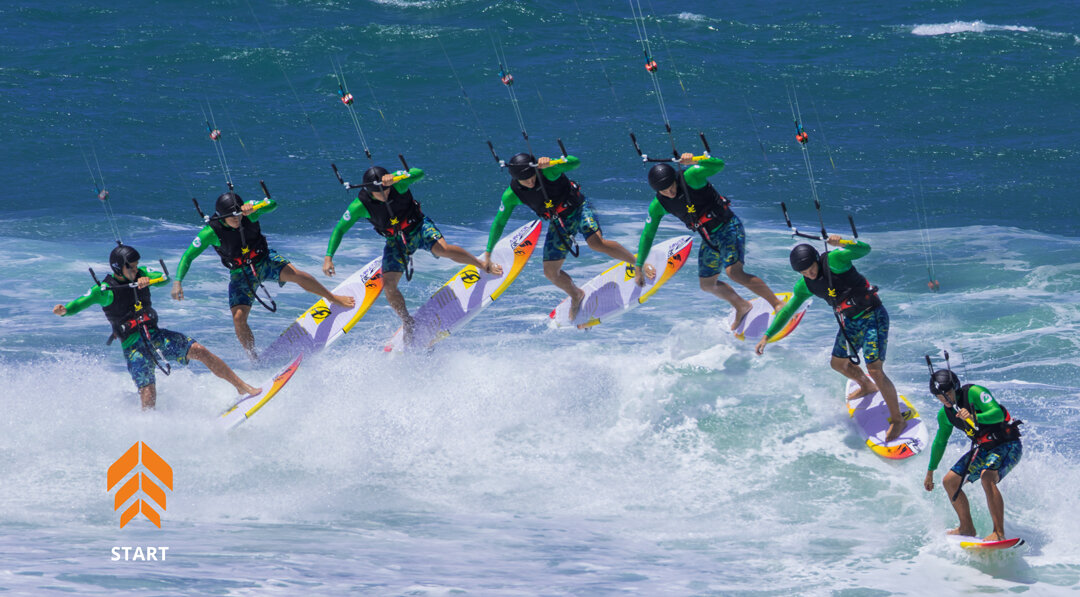
In addition to water, to make the area more “kiteable”, you will want the water to have the least amount of obstructions in and around. Having limited land to launch a kite can be a dilemma for launching though having crowded waters can make it completely “unkiteable”.
With further training, if the land has limited space, you can launch your kite in the water or off a boat (with proper instruction and assistance). Depending on the temperature of the water you will have to consider using a wetsuit.
Spots and Locations
Any place in the world where the wind is good and the waters are safe you might now find a kitesurfer. Indeed, new locations for kitesurfing are being discovered on a yearly basis which is allowing more and more people to learn the sport and in return, to keep finding new potential spots.
This snowball effect is currently happening within the kitesurfing world which makes it very interesting times to join the movement. One of the true pleasures of kitesurfing is varying the conditions in which we kite, allowing us to experience new and exciting sensations.
Some of the most popular kitesurfing spots in the world are kite meccas like Cabarete (Dominican Republic), Tarifa (Spain), Jericoacoara (Brazil), Cape Town (South Africa), just to name a few. Not only the conditions are great at these locations, but what makes them popular is also everything off the water such as an active kitesurfing community and the tourist infrastructures to welcome kiters from all over the world.
For more information on the best spots and locations in the world to go kitesurfing, you can visit our Destinations guide to find your next travel adventure!
What Skills Do You Need To Kitesurf?
Up to this point, we know about the history of kitesurfing, the equipment and the conditions to kitesurf. Now… what about you? The rider (or soon to be!). What skills do you need? Are you too old? Too weak? Do you even have what it takes to fly a kite?
Well, let’s cut to the chase right now: Contrary to what one might think, at first sight, kitesurfing is for everyone (yes, even for you). To help you understand this statement, let’s have a look at the skills needed and the physical requirements to kitesurf.
Skills needed to kitesurf
Kitesurfing is not hard to learn but it is a very technical activity. Considering the equipment needed to practice the sport, anyone has to go through the learning process with a qualified instructor.
There is no prior experience required to learn kitesurfing. In terms of skills, the bare minimum is to be able to swim. Every other skill you need you will learn with a qualified instructor.
Now, if you have experience with any other wind sports (such as windsurfing or sailing), it might help you understand more quickly the theory behind flying a kite and using the wind to pull you. However, you would still need to learn how to control and fly a kite, as there is nothing quite like it (it’s not hard, but it is not necessarily intuitive for everyone).
If you have experience in other board sports such as surfing, skateboarding, wakeboarding or snowboarding, it might help you with your balance when getting onto the board, but it is by no means a guarantee that you will nail it on your first try.
Compared to other board sports, the rider’s stance is different since in kiteboarding our weight is shifted on the back leg and we mainly use the heel edge of the board to ride against the pull of the kite. Moreover, 80% of the sport happens in the air with the kite. This makes it inevitable for you to take lessons and get familiar with controlling a kite.
With all of that being said, some prior skills and abilities can make a difference when you’re learning kitesurfing:
- Good eye-hand coordination can generally speed up the learning of flying a kite.
- Having a good balance helps to stand up on the board and get on riding.
- Being able to keep your cool under pressure can help you relax and feel the input of the kite on the control bar when piloting the kite.
- Being patient and optimistic will ease your progression.
But if you were not born with these abilities or qualities, fear not! You will learn and practice all of them with your instructor when learning how to kite.
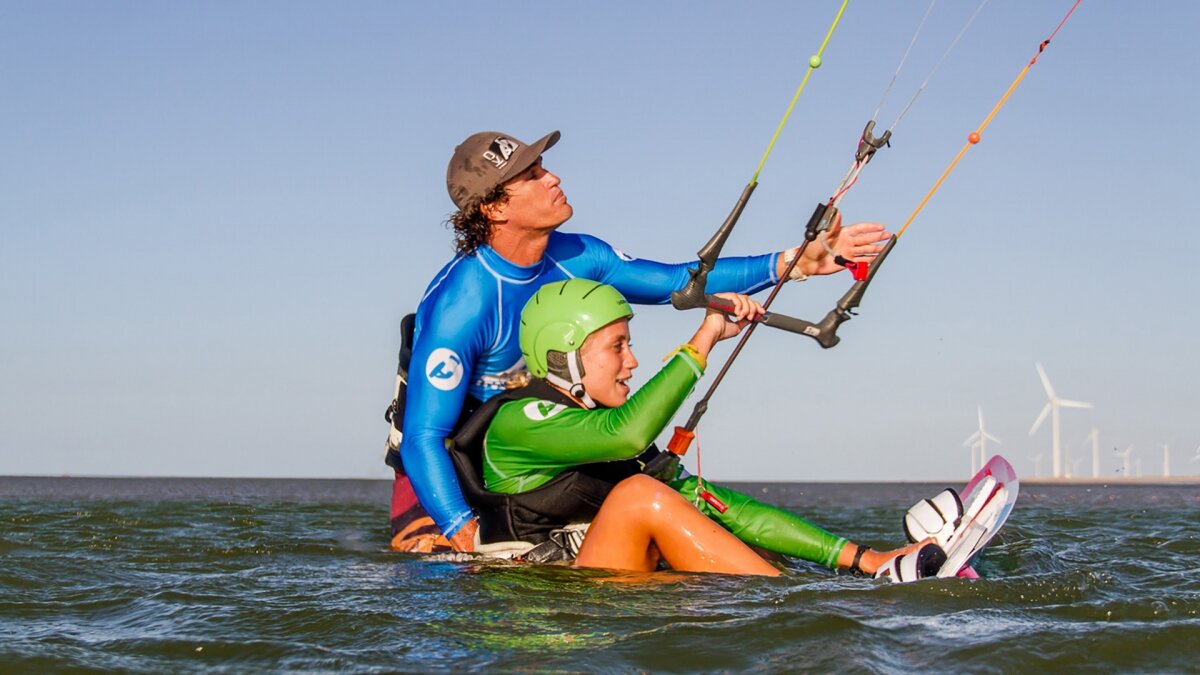
Physical requirements to kitesurf
As we mentioned already, you do not need to be Superman to kitesurf (but you too can fly!).
The kite is strapped to you through the harness, which means that you do not have to hold on to the kite with your arms. Your harness is there to absorb the pull from the kite and spread the force from your core to your whole body. The control bar enables you to sheet out the excess of pull from the kite. As we covered already, the harnesses come in various sizes and rigidity. As a beginner, you are more likely to start with a seat harness that straps around your waist and your thighs for added comfort and stability.
That being said, kitesurfing remains a sport and still demands some sort of basic physical abilities. Essentially your core stability, upper body strength and aerobic fitness are being taxed when kitesurfing. If you are thinking to train any area of your body for kitesurfing consider those three areas:
- Your upper body strength will help you carry your equipment in and out of the water as well as steer your kite efficiently.
- Having core strength will help reduce the chances of bodily injuries and maintain comfort during those long sessions.
- The only way to have long sessions though is having a healthy heart and good lungs especially once you begin trying to push your limits with tricks or riding in stronger wind conditions.
Overall, you are putting in an effort when kitesurfing although, with the new technology and equipment of today, it is way less demanding than it used to be (especially in the very beginning!). This is one of the reasons why the sport is growing at an accelerated rate: it can be practiced by people of all shapes, sizes and ages in different conditions all around the world.
Too young or too old to learn kitesurfing?
Spoiler alert: There is no age limit to learn kitesurfing. In fact, the sport is being practiced and enjoyed by children as much as seniors (and everyone in between).
Our recommendation is that children should be at least 30kgs (65 lbs.) to start. Below that weight, chances are they won’t be able to hold their ground against the pull of a kite (even a small one). Also, it is good to keep in mind that kids younger than 8 years old might not have the motor skills, attention span or even desire to learn to kite.
On the other side of the spectrum, there is no age cap to practice kitesurfing. When learned the right way, meaning with a qualified instructor in favorable conditions, kitesurfing can be very safe and enjoyed for a lifetime.
Though if you are older, you can take a prudent approach to ensure that your back and knees are in healthy condition. If you are suffering from major back or knee problems (amongst any other “major” problems) it is recommended to consult your doctor first and then a professional kite instructor to get appropriate guidance and recommendations.
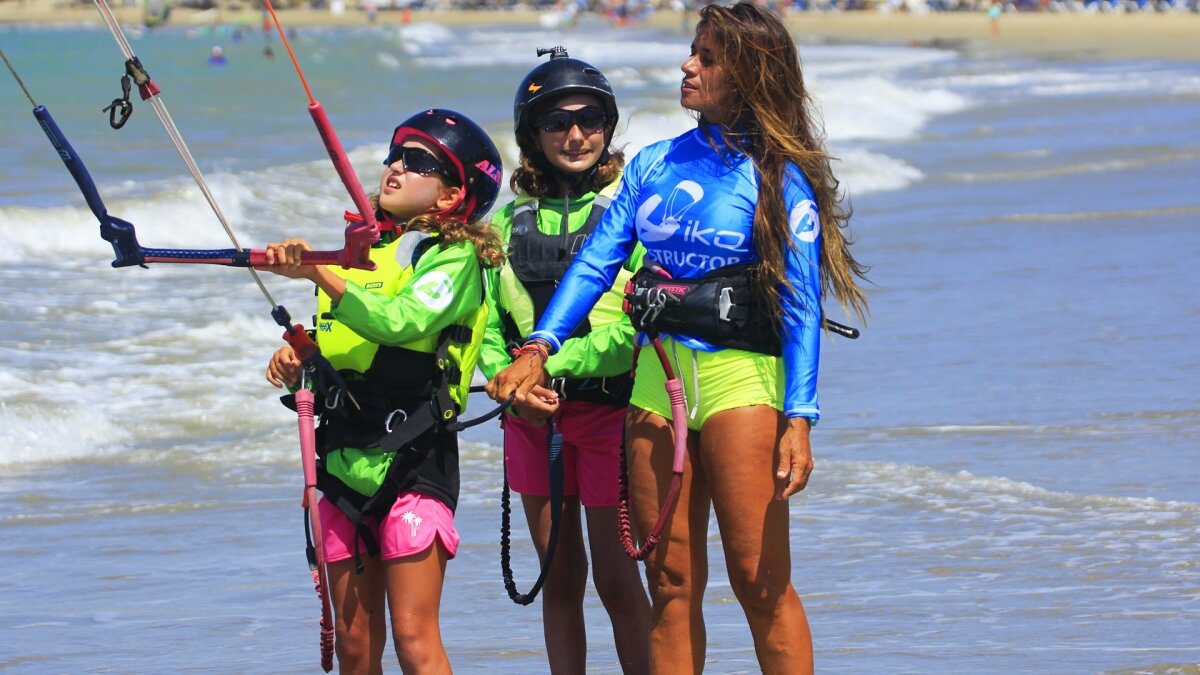
Can People With Disabilities Learn Kitesurfing?
The word disability covers a large range of possibilities and the sport is so new that not all possibilities have been tested yet. What we do know and have seen are some great examples of people with the will to learn that have successfully accomplished their goals on the water.
Whether you are missing a limb or are lacking some function in some area of your body, it has been seen conquerable from other kitesurfers. When there is a will there's a way and in kitesurfing there is no exception.
What Are The Benefits Of Kitesurfing?
The benefits of kitesurfing are plenty, no wonder why so many people join the sport year after year. Let’s take a look at this awesome sport can do to you on a physical, mental and social level.
Physical Benefits
What if we tell you it’s possible to exercise and get fit without even noticing it? That’s pretty much what kitesurfing will do to you! Trust us, you will have so much fun out there on the water that you won’t even realize that you’re actually working out.
Kitesurfing is great for strengthening the core muscles (abs, mid and lower back) and lower body muscles (butt, hips and thighs). Training those muscles leads to a better balance and stability on and off the water as most sports or activities rely on strong and stable core muscles.
As we briefly mentioned above, practicing this sport will also help you improve your physical abilities such as eye-hand coordination, focus and concentration, balance, reflexes and reaction time. As an action sport, kitesurfing requires your brain to tune in with your body to react accordingly to the outside stimulus.
Practicing these skills will have a great impact on your daily life and make you overall sharper and more aware of your surroundings (almost like having superpowers isn’it?)
Mental Benefits
On the mind side, the practice of kitesurfing is often brought up as an incredible relief for mental disorders. There aren’t that many activities where you have no choice but to completely shut your brain off and totally immerse yourself in the present moment. Kiteboarding requires you to be 100% conscious of what’s happening around you: it’s way more about feeling it than thinking about it.
Therefore, kiteboarding is known to be a good practice to invite mindfulness in your daily life. Maintaining a constant awareness of the present helps getting rid of unnecessary thoughts and relieve ourselves of any stress (much like any kind of meditation). Kitesurfing also brings you outdoors and has you sync body and mind with the elements. When you’re out there flying between wind and water, it is a great occasion to remind ourselves that we should stay humble and respect Mother Nature!
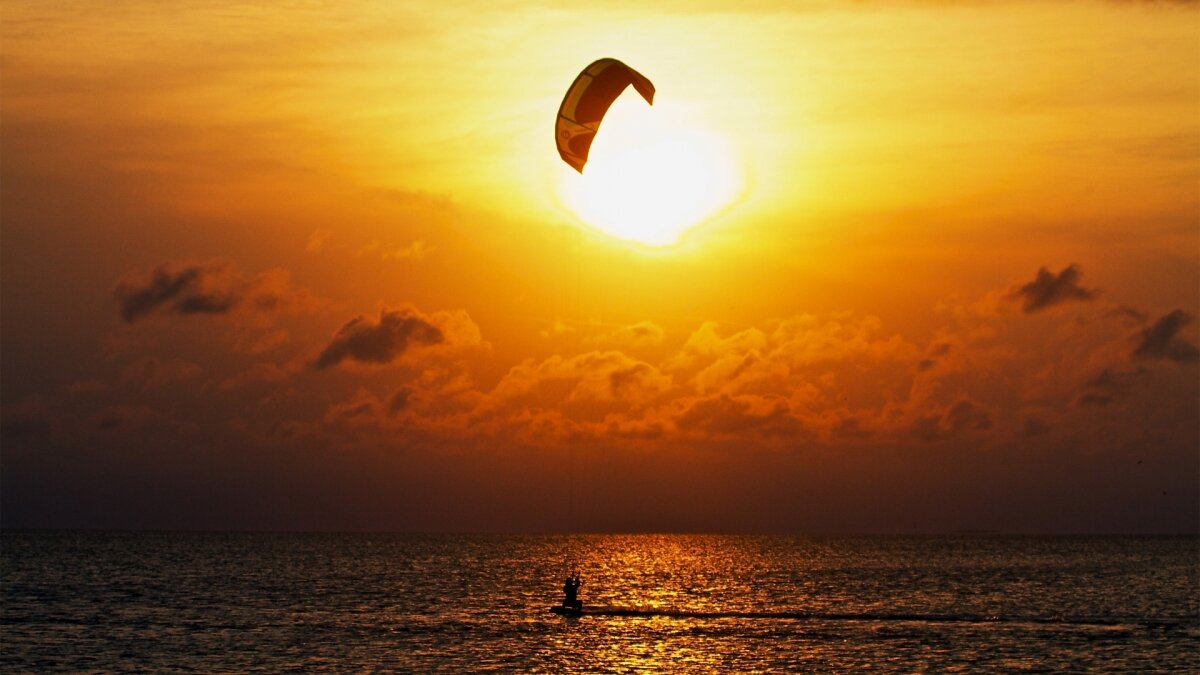
Social Benefits
Last but not least, kitesurfing is a powerful opportunity to bring people together. The kiting community is big and thriving. People from all horizons and walks of life come to the sport for a reason and another. And it’s always a real pleasure to gather with one another and share the one thing we have in common: our passion for kitesurfing.
Kiteboarding will have you meet people from all over the world whether you stay at your home spot or travel around. Speaking of travel, kitesurfing encourages slow travel and will often bring you to uncommon travel destinations where you wouldn’t necessarily go if it wasn’t for your search of good wind and waters. This is great if you like having a more authentic experience that’s off the beaten path while getting in touch with the local culture and people.
The benefits of kitesurfing are truly unlimited. Overall, it will make you feel good (body and mind wise), while enabling you to meet interesting people from all around the globe that are just as stoked for wind and adventures as you are!
Kitesurfing Is A Way Of Living
Kitesurfing is truly more than a sport, it’s a lifestyle. Not only is it super addictive, but the fact that you are so dependent on the elements makes you organize your life around the wind forecast (in a very positive and exciting way!).
Kitesurfing is not only a sport that hardcore watermen and waterwomen of all ages enjoy and practice... It is also practiced by lawyers, plumbers, fire fighters, school teachers, weekend warriors, entrepreneurs, middle school boys and girls, tech tycoons, astronauts (probably) and everything in between. What other action sport can say that? On top of that, what other sport can you see being practiced at the same time at different levels by all these different combinations of unique individuals?
When you’re out there on the water, it is you, your equipment and mother nature. In that sense, it is quite a solo sport. Of course, you’re sharing the space with other kiters (and need them for assistance on the beach), but ultimately, you are the only one feeling the sensations from your own riding experience. Kitesurfing for some people is a yoga challenge for the mind and body and this is extremely satisfying.
That being said, kiteboarding is better enjoyed as a group on and off the water by doing clinics, travels or downwinders (kitesurfing excursions). On the water, not much talking happens... it is more about sharing smiles (and occasional high-fives!). Off the water is where the social chattery takes place; usually about the previous or coming kitesurfing sessions.
The social aspect of kitesurfing is very interesting as it attracts an array of different types of characters from all walks of life. Kitesurfing brings all these people together and on the same footing, which in the end offers great networking opportunities. Hence why some say kiteboarding is the new golf!
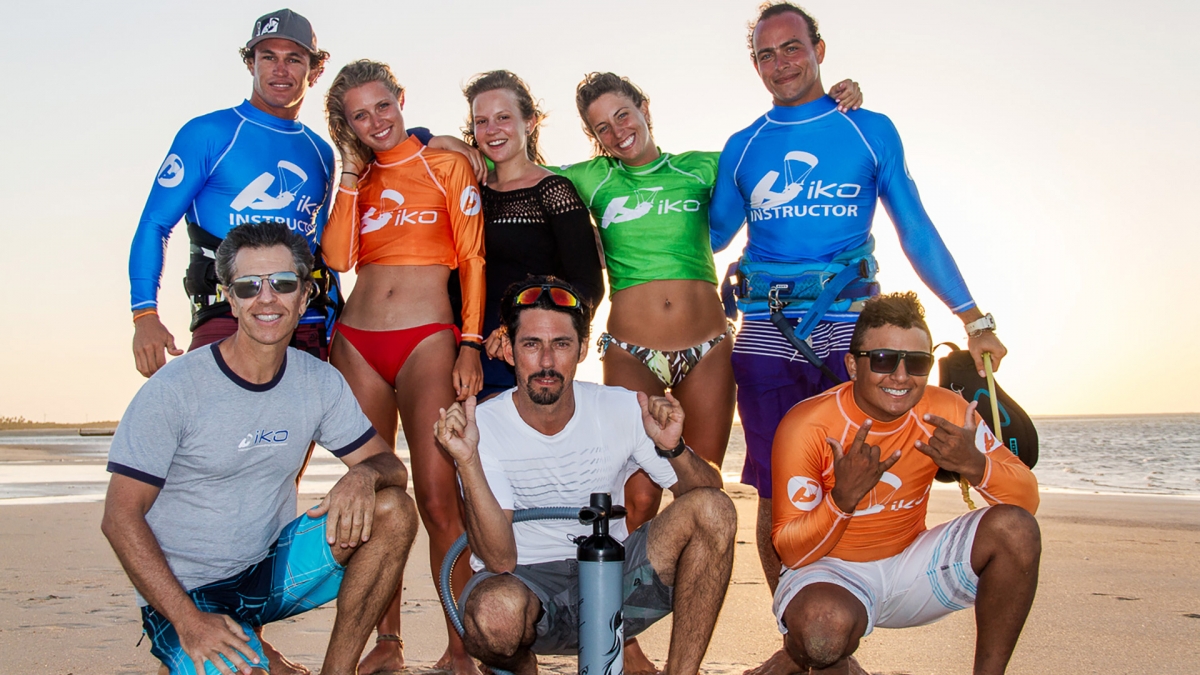
Styles of kitesurfing
Kitesurfing can be practiced in various different ways. Up above in the equipment section of this guide, we spoke about the different kites, harnesses and boards. All these various equipment options offer different possibilities in terms of riding styles.
Some riders enjoy riding larger kites, with smaller twin tip boards to boost off waves and do board offs while other riders enjoy riding small kites with a surfboard and playing in the waves. The list doesn’t end there - you have riders that enjoy riding hydrofoil boards up and down the coastlines while some individuals like getting in groups and going on downwinders together along the coastline of Brazil for example.
The different ways one can express themselves in kitesurfing varies greatly, though the different styles can be broken up into broad categories of old school and new school. One being more laid back while the other being more radical and extreme. On top of these different schools of riding, you can find different disciplines such as:
- Freeride: This is the most popular style of kitesurfing, because it is the most natural path of progression after you’ve become an advanced kiter. Freeride is all about enjoying your time on the water without boundaries, performing tricks while flying, exploring coastlines around the world and looping yourself around!
- Freestyle: It is another popular style although is not for everyone, as it requires a strong dedication to progress and go bigger, learn unhooked tricks and kite loop yourself into zero gravity for a split second. This style is often used in worldwide competitions.
- Wave Riding: This style is for those who enjoy carving a board in the waves to experience a feeling close to tow-in surfing. The kiter gets into position with the pull of the kite and catches the wave to ride it all the way down. This style often involves the use of a directional board (with or without foot straps).
- Hydrofoil: The latest trend in kitesurfing, hydrofoil uses a board mounted on a mast with a wing underneath that enables the rider to hover on the water. The sensations can be described as riding a magic carpet! Hydrofoil is a great alternative when the wind is light.
And more: These are just 4 of the most popular kitesurfing riding styles, but some people will enjoy other disciplines such as wakestyle, racing, speed riding, etc.
To each their own! Kitesurfing offers nearly infinite possibilities (and keep in mind we now only scratched the surface of this topic, we didn’t even mention the fact that you can kite on the snow or on land!).
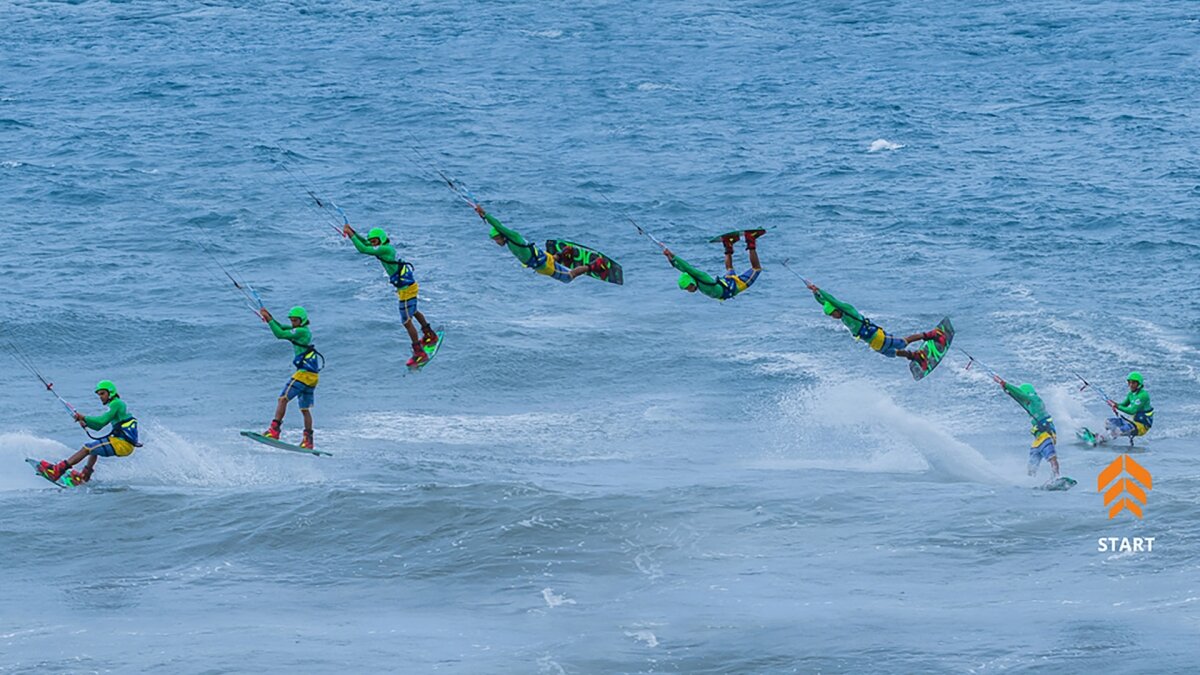
World Records
World records in kitesurfing? You best believe it! Kitesurfing has many world records done whether “officially/unofficially”. Here are some recent world records:
- Alex Caizergues breaking the world speed record, reaching a speed of 57.97 knots or 107.36 km/h.
- Maarten Haeger holds the WOO world record for the highest jump in kiteboarding at a whooping 32.0m.
- Airton Cozzolino holding the record strapless surfboard hang time at 19,03 seconds which does not beat Jesse Richmans hang time record though it is definitely interesting that Airton did it on a strapless surfboard adding that extra notch of difficulty.
- According to the Guinness World Records, the longest kitesurfing journey (as a single, non-stop journey) is 862 km (536 miles; 465 nautical miles) and was achieved by Francisco Lufinha (Portugal) who travelled from Lisbon, Portugal towards Madeira, Portugal, from 5 to 7 July 2015.
There are many more records out there that are unofficial like the youngest kitesurfer in the world as well as the oldest kite surfer in the world! Whether you are into kitesurfing to push yourself and breaks records, or simply to have fun and empty your head while cruising around, what is important is that you enjoy yourself out there!
Competitions
As the sport grows and develops, the competitive level rises equally. Kitesurfing competitions are happening in almost all disciplines and styles. The most popular ones are probably the freestyle, wave riding, hydrofoil and twin tip race competitions hosted by the GKA Tour that are happening every year around the world in different locations.
In addition to formal tours, you have many large and small “one-off” competitions happening around the world. One of the largest yearly events in the world that captures the attention of many kiters and non-kiters is the Red Bull King of the Air that happens in Cape Town, South Africa. This competition challenges the top big air kiters of the world to not only go higher than the other riders though to push the limits of what is possible while doing so. This could mean jumping 25 meters in the air, looping your kite below yourself while doing a late spin on your way down and landing cleanly (sounds impossible though they are doing it).
The different competitions require different skills. Some events and disciplines are more strength and risk orientated like Red Bull King of the Air while other events and disciplines are more strategically oriented like foil slalom racing which is to take place in the Paris 2024 Olympics!
Conclusion
Kitesurfing is an amazing sport that everyone should learn and practice! We hope that after reading this Complete Beginner’s guide, we succeeded in transmitting to you our passion for kitesurfing. For those of you for whom this reading might spark an interest, let's meet again in the next installment of our ultimate guides: How to learn kitesurfing?
Aloha and Windy Regards!
.png)

